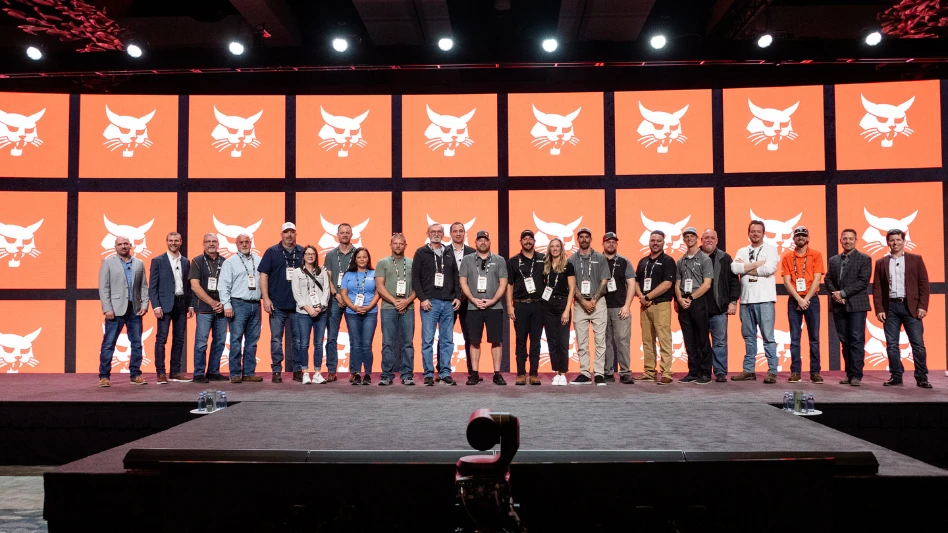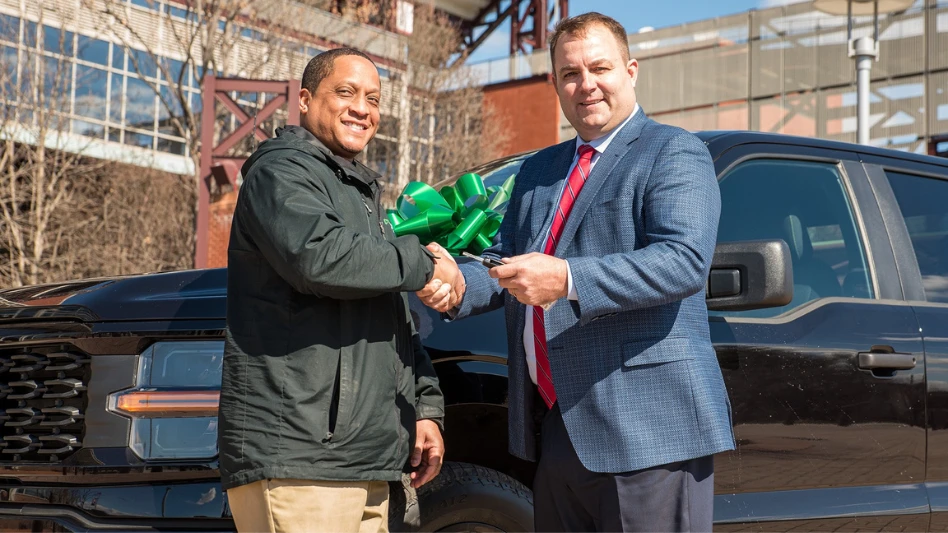Although winter is still well underway, pesky spring weeds will soon sprout. To prevent a lawn from being overtaken by a sea of crabgrass upon spring thaw, many lawn care operators (LCOs) rely on preemergent herbicides to help control outbreaks before they start.
“If you don’t apply a preemergent, you’re asking for trouble and you’re not safeguarding yourself for the upcoming season at all,” says Scott Orndorff, service center manager for LESCO, Upper Marlboro, M.D.
|
|
Preemergent herbicides are designed to stop weed growth before it begins. They are primarily used to control annual grassy weeds like crabgrass, but some forms of preemergents do control certain types of broadleaf weeds as well. Applying preemergents is a prominent service in the landscape industry, offered by 57.3 percent of LCOs, according to Lawn & Landscape research. In fact, 53.1 percent of LCOs purchased preemergent herbicides last year, spending an average of $3,573 each. About 47 percent of LCOs plan to purchase preemergent herbicides in the next 12 months, and 7.1 percent plan to add preemergent weed control as a new service this year.
TIMING IS EVERYTHING. According to Mark Urbanowski, senior product manager for Dow AgroSciences, Indianapolis, Ind., preemergents are most effective when applied before soil temperatures reach 55 degrees Fahrenheit, when crabgrass germinates. Application time varies throughout the country, as weeds have longer and earlier germination times in areas that stay warmer during winter months, like in the South and West. Because of this, LCOs in colder areas can get away with applying a preemergent in the early spring upon first thaw, while those located in warmer areas may feel that a fall application is better in order to stop weed growth before it starts, points out Jason Kuhlemeier, marketing specialist for Bayer Environmental Science, Research Triangle Park, N.C.
And some climates are so finicky they require split applications, or half of the herbicide in the winter or early spring and half in the late summer or early fall, to garner the best control. According to Steve Stansell, lawn care market manager for Syngenta, Greensboro, N.C., this is effective in warm-season climates that have longer growing seasons and earlier crabgrass germination. “In areas south of Atlanta, lawn care operators have to apply preemergents in January and then again in late spring or early summer for them to be effective through August,” he explains. “In the Midwest, the ground doesn’t thaw out until March or early April so they can wait until after the snow clears for the first application and then may only need to do it once.”
Regardless of where you are located, experts advise applying a preemergent as close to weed germination time as possible to get the best control, and say timing can be determined by knowing your region and by staying in touch with universities and other organizations that focus on plant growth. After all, doing the job well the first time around can decrease client callbacks and the need for additional applications. “Timing is so important,” Orndorff says. “If you don’t get the preemergent down at the right time of year, you’re going to battle certain weeds all year.”
According to Urbanowski, applying a preemergent too early allows time for weeds to germinate and grow after the herbicide has worn off, while applying too late counteracts the purpose of using a preemergent in the first place by missing the optimal application window.
PICKING PREEMERGENTS. Depending on the type of product you use, preemergents can last anywhere from 30 to 45 days to three to five months after application. There are preemergents for cool- and warm-season turfs that specialize in killing different species of weeds that come in liquid or granular forms. With the variety of options available, knowing exactly what you want your preemergent herbicide to accomplish before choosing one for application is important.
In terms of which preemergent to purchase, many LCOs consider price and efficacy, and have found that saving money by purchasing inexpensive products is not always the best way to go. “It’s always a balancing act between cost and effectiveness,” says Tim Doppel, owner of Atwood Lawncare based in Sterling Heights, Mich., pointing out that the average cost of preemergents is around $195 a gallon, compared to $66 per gallon for a grassy-weed postemergent and $10 per gallon for a broadleaf weed postemergent. “You just try to get the most bang for your buck.”
LCOs also choose a preemergent based on the types of equipment (spreaders or sprayers) they are comfortable handling, the number of applications their specific region calls for and, most of all, their personal preference.
EMERGING TRENDS. As trends in preemergents arise, LCOs will have even more factors to consider when choosing a product. One such trend is the arrival of generic preemergents. While they may cost less, industry experts suggest that LCOs do their homework before investing in any product. Similar to machinery, many manufacturers of brand-name products offer continued support and training sessions on how to use herbicides, a luxury they say may not always come with generic brands.
Other new products on the horizon will combine existing preemergents in an effort to provide a larger weed-control spectrum, Stansell says.
| USING PREEMERGENTS IN BEDS |
Weeds can sprout up anywhere, including in a client’s flower bed, and a preemergent could be just the thing to keep this problem under control. However, applying preemergents to beds can be a bit trickier than one may think. “In beds, weeds have a better chance to grow because they don’t have as much competition as they do in a patch of turf,” says Jason Kuhlemeier, marketing specialist, Bayer Environmental Science, Research Triangle Park, N.C. “Herbicides can be more necessary in a bed.” Though many studies regarding the effects of preemergents in beds have been done, manufacturers say there is still much progress to be made in this area. One of the reasons is because there are thousands of varieties of ornamentals compared to roughly 10 varieties of turf, making it harder to test the safety and efficacy of preemergents on ornamentals, explains Mark Urbanowski, senior product manager, Dow AgroSciences, Indianapolis, Ind. Because of this, most manufacturers won’t label a preemergent specifically for beds, although a few do exist. Applying a preemergent in a bed also requires compact equipment, such as a backpack sprayer, to treat tighter spaces, says Steve Stansell, lawn care market manager, Syngenta, Greensboro, N.C. “You can’t spread the product through a bed very easily, but you don’t want to spray flowers and shrubs with a liquid application either,” he says. “It’s a little more of an art than treating turf.” Other challenges include having to apply the herbicide underneath mulch, rocks or other material spread throughout a bed, and making sure not to apply the product on desired plant material. “However, beds offer a wider window of application, so timeliness is not as important of an issue as it is with turfgrass applications,” says Tim Doppel, owner, Atwood Lawncare, Sterling Heights, Mich., pointing out a positive. And, if done correctly, treating beds with preemergents can be a profitable service for a lawn care company to offer. “We have found the service to be about 20 percent more profitable than our others, primarily because it’s a premium service,” Doppel says. “Our customers who get it love it because bed weeds are one less thing they have to worry about.” Doppel sells this service as an add-on. “If a technician is out doing routine lawn care and sees some weeds in the client’s flower beds, he will inform the customer and let them know it’s a problem we can fix,” he says. To price such a service, Urbanowski suggests considering ornamental varieties, square footage, product quantity (bed preemergents average $3 to $3.50 per 1,000 square feet, according to Doppel), application timing and callback insurance (if your company guarantees weed control for the entire year). The final amount should then be tacked on to a typical turfgrass application. “It’s a very natural add-on opportunity,” he explains. “It just makes sense for homeowners to pay to get their beds treated if they’re paying to get their lawn treated.” |
Another trend in the preemergent market is the shift from solvent-based products to water-based products. According to Urbanowski, some of the solvent-based products currently on the market have eye or skin irritants and strong odors that require warnings, or “signal words,” that can draw negative attention to the products. Water-based solutions have milder ingredients and odors, which require less need for these warnings.
“Most homeowners like the fact that their lawns don’t smell strongly of chemicals after an application of a water-based product,” he says. “Also, manufacturers are finding that water-based formulas are easier for lawn care operators to work with, because they are easier to mix, shake and poor.”
While treating a lawn with a mixture of an herbicide and a fertilizer at one time is not a new concept, new combinations including three substances, such as a preemergent, a fertilizer and a broadleaf postemergent, is. This idea aims to further reduce the number of times LCOs need to visit a lawn, saving time and money.
SELLING YOUR SERVICE. Most lawn care companies sell their herbicide services based on thousands of square feet. Some base their lawn care packages on a certain number of applications per year, on average about five or six, while others feel it’s more efficient to promote a “weed-free” lawn regardless of the number of applications necessary. According to Doppel, on average, LCOs charge approximately $280 per year for their lawn care service providing between four and six applications, averaging $45 to $70 per visit.
The benefit of promoting a weed-free lawn over individual applications is that the LCO has the discretion to treat the lawn, with both pre- and postemergent herbicides, on an as-needed basis. Some LCOs have found that when clients are promised a certain number of individual applications, they will expect them whether they are needed or not. “If a lawn is green and healthy, you certainly don’t have to apply an herbicide five or six times a year,” Urbanowski says.
In addition, when a lawn is treated with a preemergent year after year, the weed seed population gradually decreases, resulting in fewer weeds each year, according to Urbanowski. “The annual use of preemergents reduces the weed pressure year by year,” he explains. “It is when a preemergent is not used that weeds grow and spread their seeds, which only perpetuates the weed problem.”
Doppel’s Michigan-based lawn care company has offered weed control services since it was founded in 1970. He sells his services by the square foot, but sells his company by promising his clients beautiful, healthy lawns.
Along with its unmatched control of crabgrass, a fairly serious problem in Michigan, Doppel uses preemergent herbicides because of the reassurance it gives his crew and his clients. “The use of preemergents gives a high degree of confidence, which you can relay to your customers and your technicians, who feel they are applying a useful, important product,” he says. “Also, if you do have crabgrass, you will have minimal problems when it’s time for it to emerge.”
Because of Michigan’s colder winter climate and later crabgrass germination time, Doppel applies the first application in the early spring. About 60 percent of his clients receive a liquid herbicide while the rest receive granular. “Most of my clients request one or the other, whichever one they perceive as better,” he explains. “However, from a weed control standpoint, I have found that the effectiveness of liquid herbicides is better.”
SPRAYING RIGHT. Whether you choose a liquid or a granular herbicide, or are located in the North or the South, proper training is important for effective herbicide application. LCOs suggest teaching your crews how to safely apply both pre- and postemergents in liquid and granular forms for a professional and productive business.
“If a preemergent is not applied evenly, you’ll have problems such as weed outbreaks in areas not covered completely,” Doppel says. “It’s an easy skill to teach, but you still have to be sure to teach it.”
Doppel requires members of his crews who have no experience in herbicide application to practice by spraying water in a parking lot accompanied by an experienced technician or manager for several days. This allows them to visualize the spray pattern they want to achieve. “It’s hands-on training that is important,” he says. “They practice this way until they have a good grasp on the correct technique.”
LCOs should also teach their clients how to help keep their lawns weed-free by informing them of the appropriate watering habits, mowing heights and other general maintenance they can perform between applications.
“Have the customer get in the material watering as soon as possible so the herbicide works as effectively as it can,” Doppel says. “However, there is a small optimal window of timing, so this is not always possible.”
Doppel stresses the importance of watering a lawn after an herbicide application because the chemical has to get down into the soil for it to take effect. He and his crew use multiple methods to get this message across to their clients including informational fliers, hand-written notes, telephone calls and face-to-face conversations.
A main goal of using preemergent herbicides is to control weeds in a way that results in fewer callbacks and happier customers. Although methods of preemergent application will vary from region to region, all businesses can benefit by using effective products correctly, informing their clients to do their part and utilizing product advancements.
“Retention is key,” says Urbanowski. “Every time you lose one customer, you spend three times the effort finding a new one. The goal is to keep customers happy.”

Explore the January 2007 Issue
Check out more from this issue and find your next story to read.
Latest from Lawn & Landscape
- North by Northwest's charitable act for the Ronald McDonald House Charities
- Coxreels expands V-100 Series product line
- Landscape Workshop expands with 2 acquisitions
- Wilson360 adds Daniel Grange as new consultant
- Batman and business
- CH Products releases new tree stabilizer
- Savannah Bananas founder Jesse Cole to speak at Equip Exposition
- Catch up on last year's Benchmarking report






